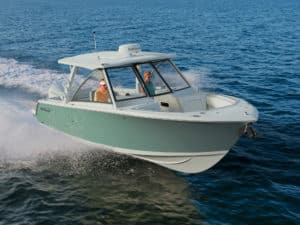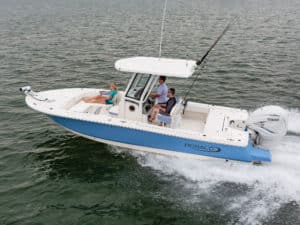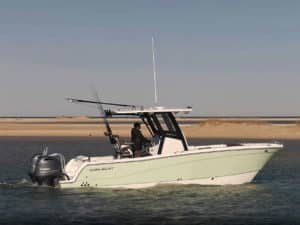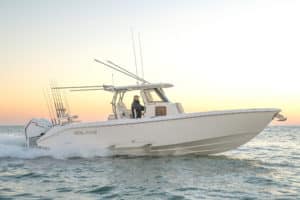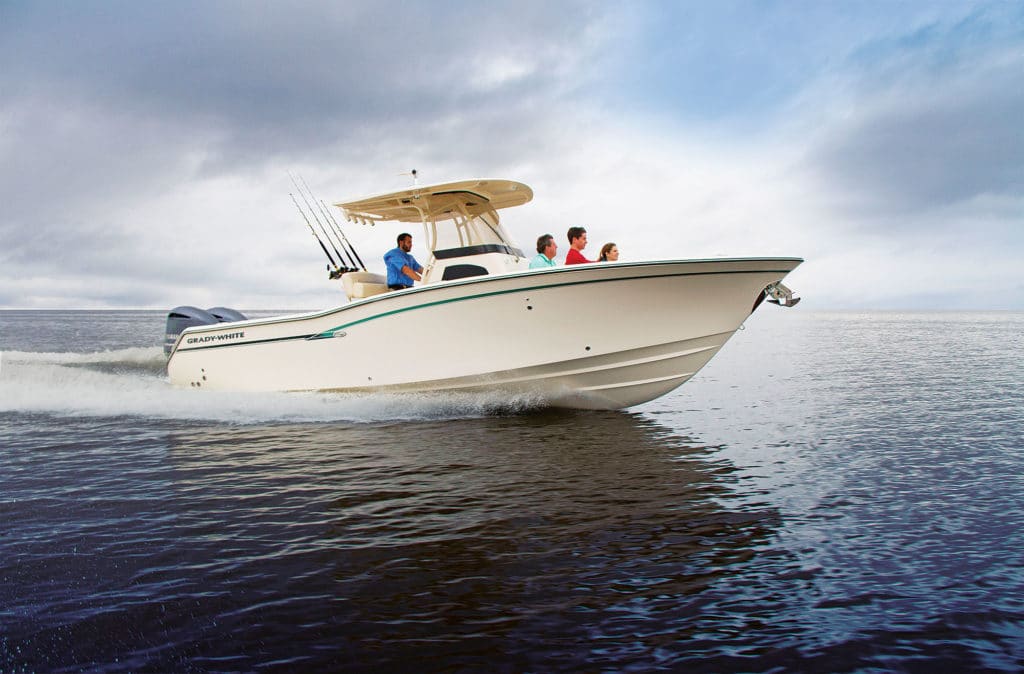
Near-gale-force winds bent over palm trees and left white streaks of foam along the creeks and channels of the Florida Keys as I met up with Capt. Billy Harbaugh and Grady-White product specialist Todd Leggett at Caribee Boat Sales & Marina in Islamorada.
My mission on this January day: Fish Trial the Grady-White Canyon 271 FS, a new model that builds on the popularity of Grady’s Canyon 271 with features that make this center-console even more fishable and family-friendly than the original.
ll, the FS model also incorporates versatile forward seating. This includes 55-inch-long benches on both sides of the bow and a seat on the forward portion of the console, with a pedestal table in the middle.
The bow benches convert into twin loungers by pivoting a pair of padded backrests out from the gunwale and locking them into position. When not in use, the backrests serve as part of the coaming bolsters that encircle the interior. The bow-seating area has an optional casting platform that converts into a sun pad with cushions. It can also become a dining area with a bow table.
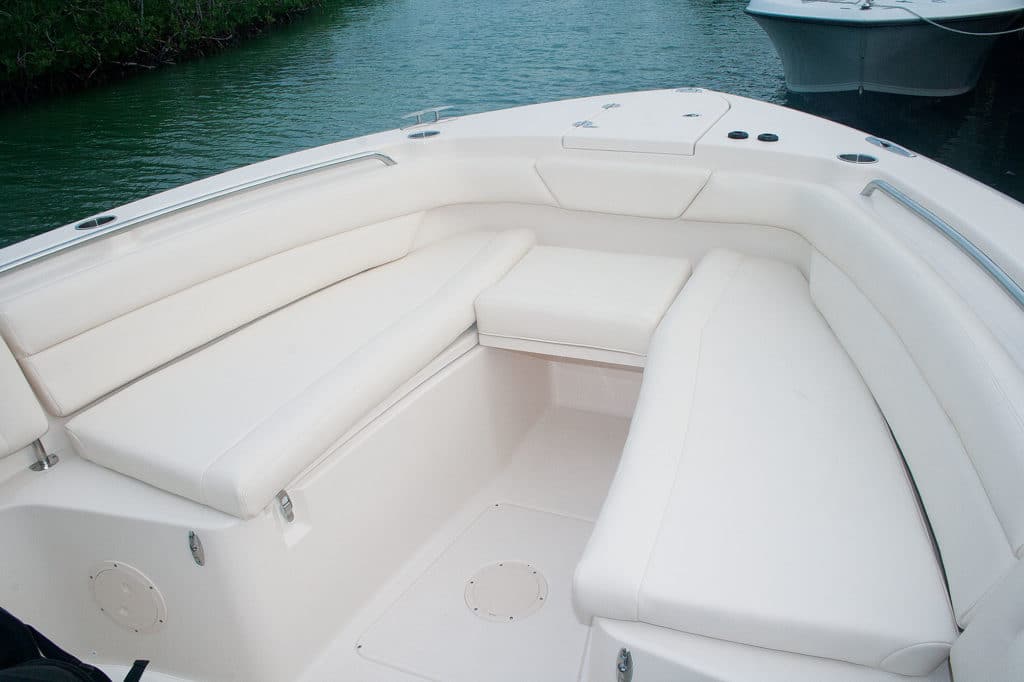
Bait Up!
The gray, blustery day did not deter Harbaugh, who prepared by transferring live goggle-eyes from a nearby holding pen into the 42-gallon livewell abaft the helm seating. This area also includes a sink and fresh-water faucet, tackle stowage, and a rack of four rod holders.
My test boat featured an optional 32-gallon well in the port quarter, which Harbaugh loaded with more goggle-eyes. With winds gusting to 30 knots out of the southeast, I half-expected him to suggest we anchor by a bridge to soak live baits for tarpon. Not so.
“We’re going to shoot out into the Atlantic and slow-troll live baits for dolphin [mahimahi] and sailfish,” the captain declared. I quickly extracted my foul-weather gear, which I had stowed earlier inside the step-down head compartment within the console. A door on the port side offered easy access, and the all-new lighting gave good visibility.
As we pulled away from the dock and made our way toward the inlet at Tavernier Creek, I came to appreciate another new feature on the 271 FS: a full-height, wraparound, scratch-resistant tinted acrylic windshield — just like those on Bell helicopters — integrated into the hardtop’s painted aluminum frame, which completely protects the helm area from windblast. A windshield wiper and washer whisk away errant spray to keep the view clear. The swept-back design lends the console a sleek appearance. Integrated into the hardtop are an overhead electronics box, dome lights, a spreader light, overhead life-jacket stowage, optional Taco Marine Grand Slam 280 outrigger mounts with 15-foot poles, and four rod holders across the aft edge.
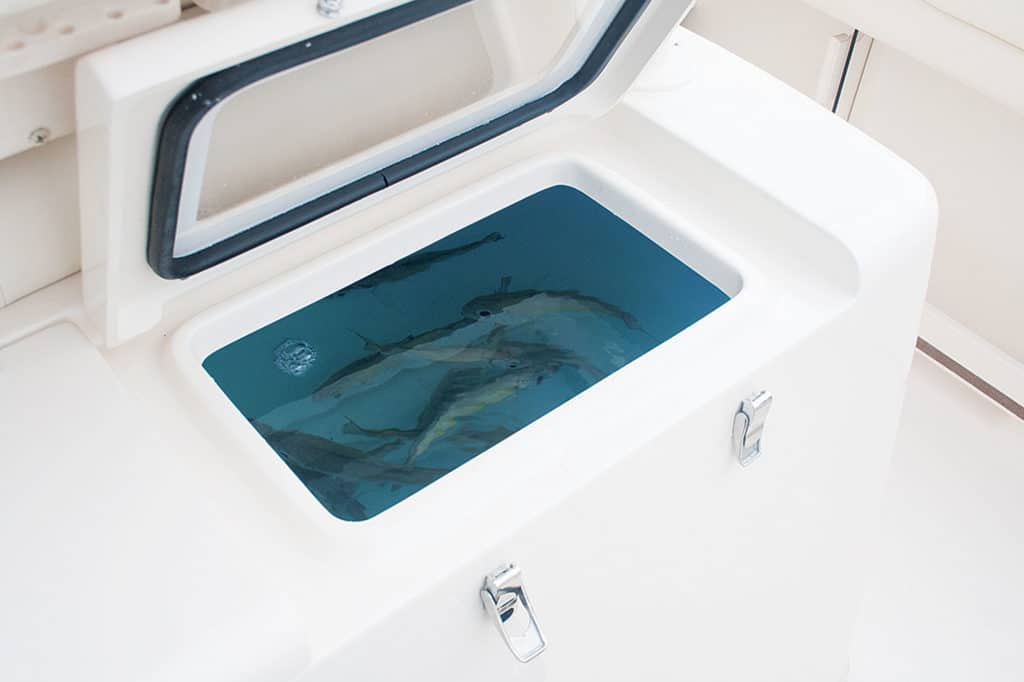
Though no marine electronics had yet been installed on this boat, a newly designed 38-inch-wide helm panel will easily accommodate a pair of 15-inch multifunction displays. Grady allows its dealers to create custom electronics installations with buyers rather than offering cookie-cutter factory packages. The vertical compass on the helm panel was very easy to read, even while seated.
I particularly liked the storage area on top of the console. A raised lip around the top and a nonskid mat inside hold items such as sunglasses, cellphones and tubes of sunscreen.
Smoothing the Lumps
Sea conditions proved worse than I expected. Inside the patch reefs, tightly spaced three- to four-footers made for a challenging run, but the 271 FS smoothed out the lumps. Powered by twin Yamaha F300 outboards, the new Grady sliced through the waves at speeds of about 30 mph at 3,500 rpm.
I found a comfortable spot at the helm, where a pair of flip-up bolsters convert each side of the seat into a leaning post, giving the captain and co-pilot the option of sitting or standing. While running inside the reef, I sat, using the angled footrest at the base of the console to brace myself.
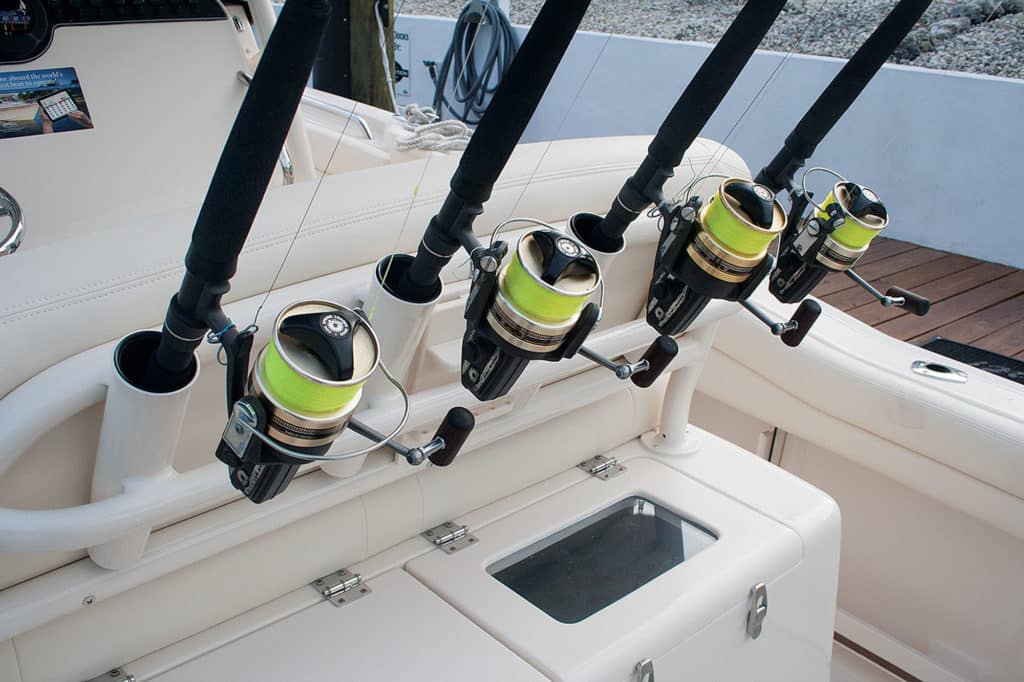
Leggett sat aft, using the patented 44-inch-wide fold-out transom bench seat. I found the folding mechanism easy to use and liked the way the seat tucks into the transom when folded. Its rounded edges prevent scratches.
Once we were offshore, the waves grew larger and steeper, averaging six to eight feet at six-second intervals — my cue to switch to the leaning post, if for no other reason than to get a better view of the seas. It was also time to decrease our speed. Harbaugh brought the twin F300s down to 3,000 rpm, where we slowed to about 20 to 25 mph, depending on whether we were climbing or descending waves.
Power-assist steering (standard with twin F300s), the tilt-and-lock helm and Bennett trim tabs eased the task of piloting the 271 FS in the challenging conditions we faced that day.
Choosing this day to go offshore fishing in a 27-footer left me genuinely concerned that we might drop into a dark hole, stuff the bow, and fill the boat with green water. Yet the Grady 271 FS surprised me in a very good way. The bow refused to dip, whether we were heading up- or down-sea — offering a strong testament to the lift and seaworthiness of the SeaV2 hull.
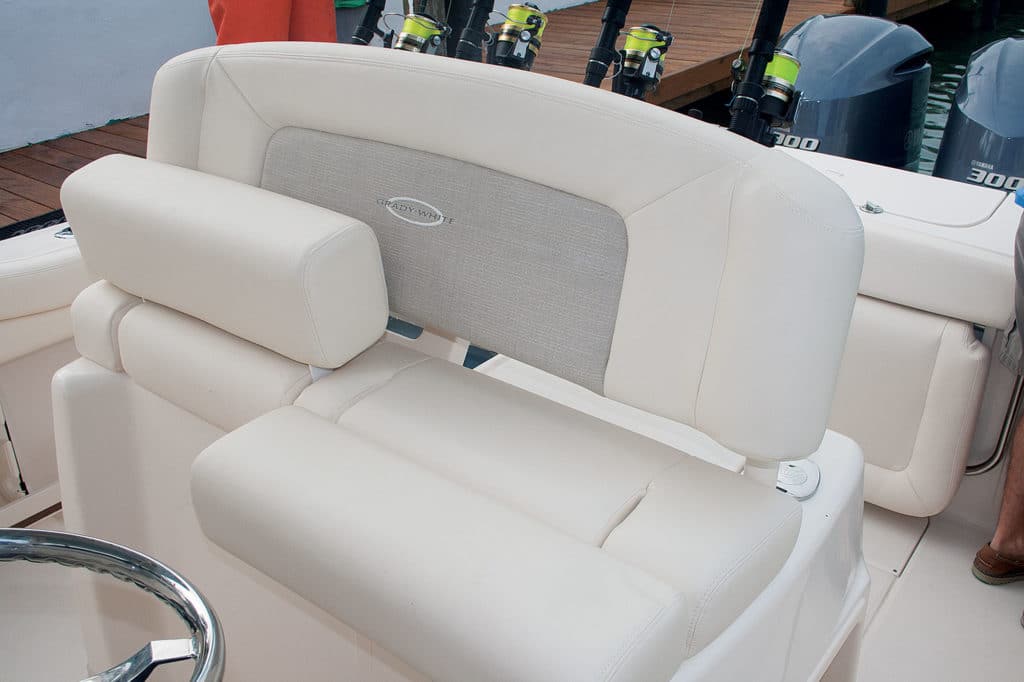
Stable and Able
About two miles outside the patch reefs, Harbaugh decided to slow-troll a spread of live goggle-eyes, bringing the throttle down to 600 rpm, which gave us a trolling speed of about 1½ to 2 mph. The 9½-foot beam provided outstanding stability as we bridled baits and dropped them back about 75 feet.
The Grady-White diamond-pattern nonskid offered great traction, even on the wet deck. A recessed stainless-steel grab rail brackets the bow, offering an extra measure of safety when going forward in rough seas to man the anchor. The anchor locker features a Lewmar vertical windlass and in-stem roller.
As we waited for a bite, I explored other features of the 271 FS and found a 67-quart cooler under the forward console seat. This is where we stashed our soft drinks for the trip. Under the forward deck lie two 85-quart insulated fish lockers. A third 198-quart fish box resides in the transom.
A transom door in the starboard quarter provides access to the swim platform for boarding, taking a dip, or fighting fish around the outboards. I also found raw-water and fresh-water washdown spigots, as well as a recessed fresh-water shower hose in the starboard quarter.
Unfortunately, we needed neither fish lockers nor washdown hoses on this trip, as the mahi and sailfish never found our bait. We did watch a kingfish sky across the spread, but alas, no bites. After three hours of battling the seas, we headed in to gather performance data in protected waters.
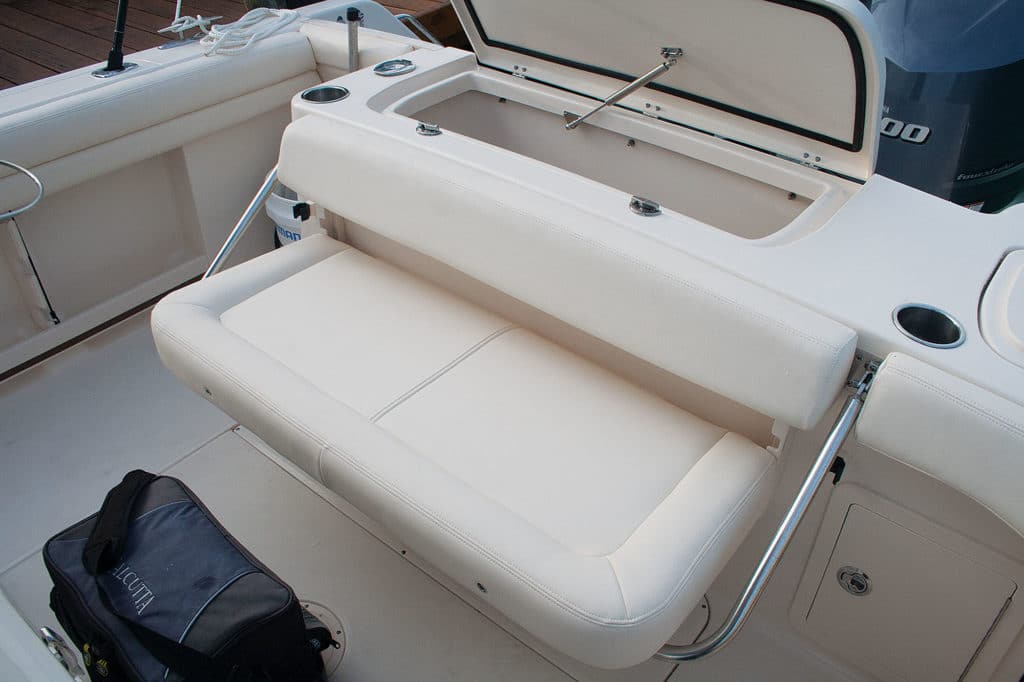
By the Numbers
With 100 gallons of fuel, full livewells and three adults on board, and turning Yamaha Saltwater Series II 19-inch-pitch, stainless-steel three-blade propellers, the Canyon 271 FS jumped on plane in 3.5 seconds and reached 30 mph in 6.4 seconds. I found a top speed of 56.2 mph at 6,000 rpm, where the twin Yamaha F300 outboards burned 51.9 gallons per hour for 1.08 mpg.
The most efficient speed came at 25.6 mph and 3,000 rpm, where the twin 300s consumed 12.4 gallons per hour for 2.06 mpg, translating to a cruising range of more than 380 miles based on the 186-gallon fuel capacity.
Once back at the dock, Harbaugh, Leggett and I agreed that we probably shouldn’t have been out there on such a nasty day, but we were grateful for having done so in one of the world’s most seaworthy 27-footers. The Canyon 271 FS ranks as a machine that serious anglers will covet. Yet thanks to an innovative new forward-seating system, it also has a soft side that families will appreciate.
PERFORMANCE
POWER Twin Yamaha F300 outboards
LOAD 100 gal. fuel, three crew
TOP SPEED 56.2 mph @ 6,000 rpm
TIME TO 30 MPH 6.4 sec.
BEST MPG 2.06 @ 25.6 mph (3,000 rpm)
HULL
LOA 26 ft. 10 in.
BEAM 9 ft. 6 in.
DEADRISE 22 deg.
DRY WEIGHT 5,790 lb. (w/o engines)
DRAFT 23 in.
FUEL 186 gal.
MAX POWER 600 hp
Base MSRP $200,380 (w/ two Yamaha F300s)
Grady-White Boats, Greenville, North Carolina, 252-752-2111, gradywhite.com

